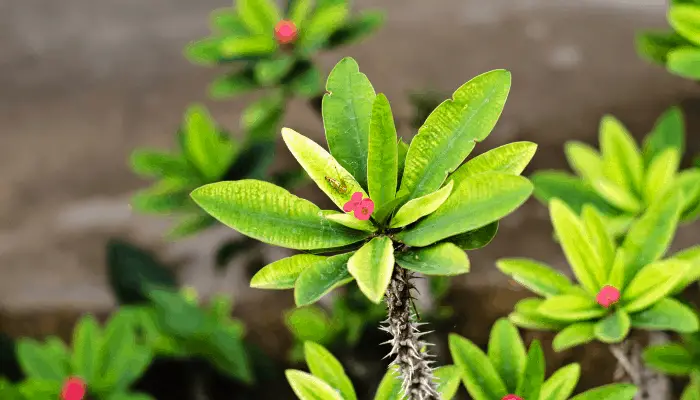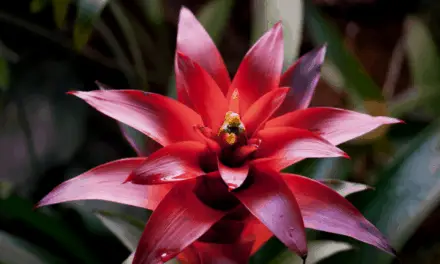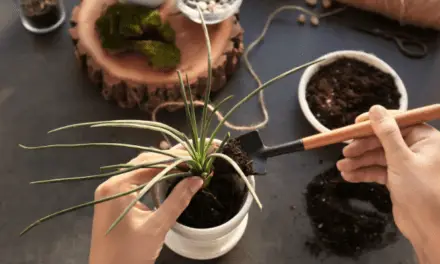Your Crown of Thorns will naturally drop leaves if it gets too hot and too dry – or too cold to conserve energy for growth. The Crown of Thorns plant does not like having its environment changed, so if you take a new plant home, its leaves may begin to turn yellow and drop off. But once it settles into its new environment, you should see new leaves beginning to grow back again.
It’s sometimes normal for your Crown of Thorns to shed a few leaves if it is under a little bit of stress but if the rest of the plant is plump, green, and looks healthy, just remove the dying leaves and the plant should be fine.
Related Article: Why Is My Succulent Melting?
Table of Contents
Why Your Crown Of Thorns Is Dropping Leaves

If you find that its leaves are shedding rapidly and the top of the plant does not look healthy, it could be a sign of more serious stress, such as:
- An environment that is far too hot or too cold.
- Not enough light and heat.
- Too much or too little water.
- Too much or too little fertilizer.
- Inadequate soil.
Even during periods of stress, loss of leaves is usually only temporary.
If the plant is healthy with only one or two branches showing signs of rot, then stick on a pair of gloves and cut them off.
It’s also a good idea to remove dying and dead leaves to prevent the spread of fungal growth.
Issues Of Moisture And Nutrients
Over or underwatering your Crown of Thorns may also lead to it losing leaves.
If there’s a lot of dryness, take a closer look at your watering and fertilizing schedule.
Unlike many other plants, the Crown of Thorns does not hold much water or need a lot of watering.
Thoroughly water the plant when the soil feels dry around one inch beneath the surface and allow any excess water to drain away.
And never let your Crown of Thorns sit in pool water or wet soil for prolonged periods as it may lead to the roots rotting and leaves dropping off.
If in a pot, the plant may not have enough moisture or it may even be time to replant it.
Root Issues
Inspect the root system by sliding the plant from the pot.
If the roots look out of control, it’s time to replant.
Transplant your Crown of Thorns into a pot that’s at least an inch larger than the previous one.
Watering Frequency
Your watering schedule should depend on climate and location.
Once every two weeks is generally recommended but you should adjust the watering schedule depending on your plant’s environmental conditions.
Only water a Crown of Thorns when the soil is dry.
Ensure excess water drains away.
Water should only soak into the soil about an inch deep.
Related Article: How Many Days Can A Succulent Go Without Water?
Moisture Balance
If the plant isn’t receiving enough moisture, the leaves may also turn yellow and drop off.
Dry leaves may indicate the need to increase water frequency.
Water it once per week when it’s active and only once per month when dormant.
Root rot may also cause the loss of leaves from too much water.
To prevent root rot, make sure there’s good drainage and that it doesn’t sit in standing water.
A Crown of Thorns relies more on moisture from its leaves than from soil, so it’s a good idea to mist it regularly.
Fertilizer
If your plant does have issues, you should stop fertilizing it until you solve the problem.
When you’re confident your Crown of Thorns is okay, then you can reintroduce fertilizing.
You can damage a Crown of Thorns if it’s fertilized too much.
Only fertilize during its active period (usually from about late spring to early fall).
Also, consider how the fertilizer may lack proper nutrients or that you give it too little fertilizer.
Once a month, use a bloom-specific fertilizer at half strength.
Too Much Or Too Little Heat And Warmth
Your Crown of Thorns should have direct daily sunlight, even if only for a couple of hours.
But remember, this plant loves desert-like conditions and can stand partial shade.
Humidity is good because of how the leaves supply most of the plant’s moisture.
The environment should also be bright and hot.
A Crown of Thorns can tolerate heat and drought but can be badly affected by frost.
Cool nights are okay if daytime temperatures exceed 60° F. Below 25° F, they will struggle and leaves may drop leaves.
If you live in a planting zone of 9 or higher, you can keep the plant outside.
But they do need darkness to flower, so don’t keep them under a grow light indoors.
How To Stop Your Crown Of Thorns Losing Leaves In A Colder Climate
Colder climates should have a Crown of Thorns in a pot.
Move it inside or outside during the winter and summer months.
The plant will do well wintering indoors, but it should be somewhere warm and sunny.
Move the plant slowly so it can acclimatize.
It may lose leaves if it experiences too much of a change in the environment.
Also, keep in mind that leaf drop occurs right before dormancy.
This period can last for several months so long as the plant stays dry.
But as soon as the weather is nice and warm, keep it outdoors.
When questioning, “why is my Crown of Thorns losing leaves,” know that there are times when it is normal.
The Crown of Thorns is a gorgeous and extremely forgiving plant to keep and if you follow a few of these basic tips, you shouldn’t have any issues at all.




